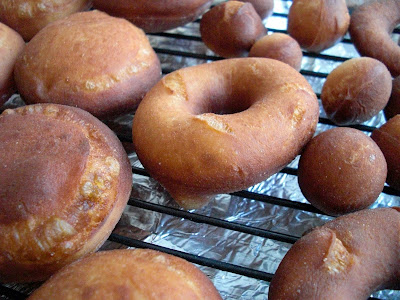Latkes (potato pancakes) are probably the best known Hanukkah food in the U.S. There are as many ways to make latkes as there are families that make them. My latke recipe was born out of many holiday seasons working as a caterer and private chef, in other words, trial and error.
I often make a mix of sweet potato and yukon gold potatoes, but you can make this recipe with any type of potato you like.
3 large sweet potatoes
5 large yukon gold or white potatoes
2 large onions
4 eggs
1 1/2 cups flour (more if needed) - or a starch of your choice for gluten free (corn, arrowroot etc)
salt and pepper to taste
oil for frying

1. Shred potatoes with a food processor or a box grater.
2. Rinse the potatoes in cold water and drain 3 or 4 times until the water is clear and the starch is removed from the outside of the potatoes. Drain well, squeezing out any excess water.
Peel and slice the onions into quarters. Place the onions in a food processor and blend until they are well chopped. Add the eggs and flour and puree until smooth.

3. Add the onion mixture to the potatoes, season with salt and pepper, and toss until the potatoes are well coated. The potatoes should have a thin coating of the onion/egg mixture. You can add a little more flour to the batter if it seems like it needs more binding. Place the batter in a colander set over a large bowl, so that the water that starts to seep from the potatoes (from the salt in the batter) is removed. Note: if your batter starts to seem too dry, you can mix a little of this liquid back in.
4. In a heavy frying pan, heat about 1/2inch of oil until a small amount of batter dropped in it sizzles as soon as it is dropped in.Using tongs or a large spoon, place small mounds of batter around the frying pan and gently press them down to make the tops flat. the oil should be sizzling very fast around the edges. when the bottoms are well browned, turn latkes over and cook a few minutes more until they are olden brown.The oil must be very hot so that they cook quickly and do not absorb the grease. If your latkes are soggy and greasy, your oil is not hot enough.


5. Remove latkes and place them on a rack to cool in a single layer. Once they have cooled, you can lean them up against each other as shown in the picture below. You can reheat latkes while they are stacked like this, the heat circulates well around them, and since they are not lying flat, none of them are absorbing oil from the bottom of the pan. To heat heat, place in a preheated 400 degree oven.


When we have a big family meal there are usually a lot of dietary restrictions to take into account. I usually find this to be a fun challenge. We have one person with celiac (my grandmotehr) and one with wheat sensitivity (my husband), so I made our latkes with spelt for the wheat sensitivity, and a batch with corn starch (or you can use tapioca starch or arrowroot) for the gluten free variety. My sister's boyfriend is a Sufi Muslim, so he only eats hallal or kosher meat. We ate fish and chicken the night before, so we opted for a vegetarian menu for this night.
In addition to our sweet potato latkes, we had:
French lentils with roasted apples and onions
Baked tofu with broiled lemons and pistachios, and a rif on a yemeni pesto called zhoug I had in the fridge (ours included garlic, cardamom, caraway seeds, olive oil and salt) it usually would have cilantro added in to make a fabulous pesto type condiment, but I didn't have any, so we made due without.

All in all it was a fun meal to make and most of all to eat!
Happy Hanukkah!!!








































